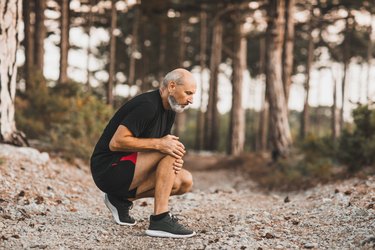
In some contexts, feeling weak in the knees is a good thing. But when you're exercising, it's definitely not. Although knee pain is a common complaint, it can sideline your workouts and halt your progress. Avoid these four common workout mistakes to keep your knees pain-free.
Warning
If you're experiencing sharp knee pain while you exercise, stop what you're doing and consult a medical professional before you get back to working out.
Video of the Day
1. Your Knees Track Inward
Poor knee alignment is among the most common workout mistakes that can lead to achy knees. When you perform exercises like squats or lunges, your knee should track over the top of your shoe, staying behind the toes, Sam Becourtney, physical therapist at Bespoke Treatments in New York, tells LIVESTRONG.com.
Video of the Day
"While it is not always bad or 'wrong' for the knees to fall inward, it can be a cause of knee pain due to increased force on the joint when lifting heavy loads," Becourtney says. Allowing the knees to drop inward can also cause pain in your hips, feet or ankles, as these other joints may try to compensate for the lack stability in the knees, he says.
Fix It
Keep your knees in line with your second and third toes when performing any exercise that involves bending the joint. Perform your exercises in front of a mirror to ensure you're staying in proper alignment.
If verbal and visual cues aren't enough, loop a resistance band above your knees. Fighting the resistance with help activate your glutes and maintain better knee alignment.
2. You Lift Too Heavy Too Soon
Lifting too much weight before you're ready is bad not just for your knees but the rest of your body as well, according to Becourtney. Adding excessive resistance to an exercise before you're strong enough can cause pain in or injury to your muscles, joints and connective tissue.
And your knees are bearing the brunt of this overload. That's why most professionals recommend training with a steady, gradual increase in resistance (aka progressive overload).
"It is absolutely necessary to provide load to all of our joints, but if you exceed the capacity of the joint and surrounding musculature without gradually utilizing the concept of progressive overload, this may lead to pain," Becourtney says.
Fix It
"To fix this mistake, people should follow a structured program that gradually increases the weight used for various exercises over a weekly and monthly basis," Becourtney says.
If increasing weight has caused an increase in knee pain, he recommends reducing the weight of your exercises (or dropping the weight altogether) and checking in with your doctor or physical therapist.
3. You're Skipping Unilateral Exercises
Muscle imbalances and asymmetries are a common result of everyday life, whether you're carrying your bag on the same arm every day or playing tennis several days a week. Generally, one side of your body will be stronger than the other, according to Becourtney.
If you only perform double-leg exercises (like squats) instead of single-side moves (like Bulgarian split squats), you may begin overusing your stronger half, he says. Over time, this can lead to knee pain and tightness as well as pain or soreness in your hips, hamstrings and glutes.
Fix It
Incorporate at least one or two single-leg exercises into all of your lower-body workouts, Becourtney says. Single-leg deadlifts, single-leg glute bridges and single-leg hip thrusts are just a few to try.
"I would suggest starting with double-leg strength movements and then incorporate single-leg variations for accessory work."
4. You're Wearing the Wrong Shoes
Your shoes play a bigger part in your workout safety than you may think. Although improper footwear usually won't directly cause pain, it may increase the likelihood of poor form and improper knee tracking (see mistake 1), which can lead to knee pain or injury, according to Becourtney.
"Choosing a shoe that doesn't match or support an individual's foot shape (higher arch vs. flat foot) can lead to these issues," he says. "Similarly, if you choose a running shoe with too much cushioning, this may alter technique of the movement, resulting in pain."
Fix It
"I recommend choosing a relatively stiff 'training' shoe," Becourtney says. "Or if you're working out in a setting that's relatively private, I actually recommend doing strength training routines barefoot."